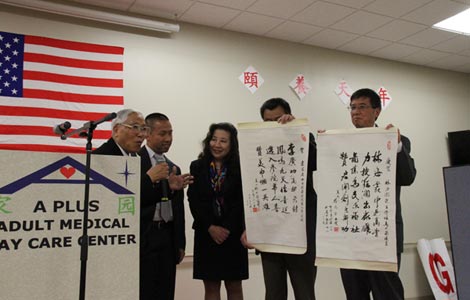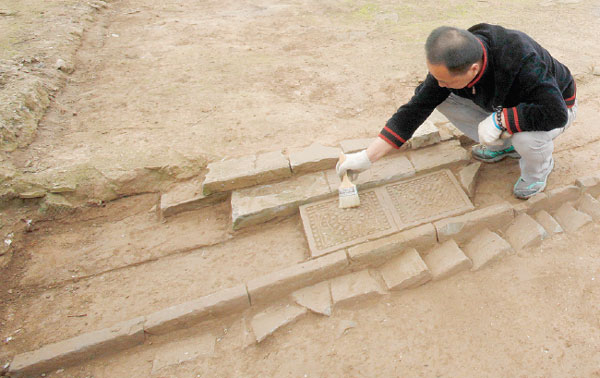Tang Dynasty offices discovered in Daming Palace excavation
Updated: 2014-11-17 07:32
By Ma Lie in Xi'an(China Daily)
|
||||||||
|
The excavation team member works on the site of the ruins of Daming Palace. Provided to China Daily |
Chinese archaeologists recently found in the ruins of Daming Palace what is believed to be the zhongshu sheng, an office responsible for drafting and issuing imperial edicts during the Tang Dynasty (AD 618-907).
According to excavation team leader Li Chunlin, of the Chinese Academy of Social Sciences' Archaeology Institute, a 50-square-meter room has been unearthed in the west of the office ruins, and a relatively small room in the north of the office has also been found.
The team began excavating in 2010 a 5,200-sq-m area northwest of Huanyuan Hall and Xuanzheng Hall, the main buildings of the Daming Palace, the Tang Dynasty imperial palace. The area was made the focal point of a projected five-year excavation from 2011 to 2016, approved by the State Administration of Cultural Heritage, after many Tang cultural relics were found there.
Two excavations, in 2011 and 2012, unearthed ruins of roads, walls, channels and an incomplete yard, said Gong Guoqiang, another excavation team leader.
Gong said that the third excavation on the site began in a 1,500-sq-m area in October, and the complete layout of the yard should be unearthed by the end of the year.
Experts say the room recently discovered might be the zhongshu sheng, because it was located in the west side of the Xuanzheng Hall. Historical records indicate that the zhongshu sheng and menxia sheng were in the west and east sides of the hall.
Archaeologists found hundreds of artifacts around the office ruins, and many of them bore inscriptions in Chinese characters reading "official" that were used by imperial officials.
During the Tang Dynasty, the central government set three sheng, or offices, and six ministries. The zhongshu sheng was for drafting and issuing imperial edicts, the menxia sheng was for checking such edicts, and the shangshu sheng was for managing government affairs. The three sheng were directly under the management of the emperor and were higher than the six ministries.
Such ruins of central governmental offices have never before been discovered, Gong said, and they provide information for the research of the ancient government structures.
The ruins of Daming Palace are located in the northern suburban of Xi'an, capital of Shaanxi province. The city was the Tang Dynasty's capital. It covered 84 sq km and had a population of over 1 million. In ancient times, it was called Chang'an and was one of the largest and most prosperous international cities in the world.
malie@chinadaily.com.cn

 Open Doors report finds increases in intl enrollment
Open Doors report finds increases in intl enrollment
 Xi attends welcoming ceremony by Australian Governor-General Cosgrove
Xi attends welcoming ceremony by Australian Governor-General Cosgrove
 21-year-old student wins Miss Model of the World China Final
21-year-old student wins Miss Model of the World China Final
 Soaring comfort
Soaring comfort
 Electoral poetry
Electoral poetry
 Ice art on display in Texas
Ice art on display in Texas
 3,000 take part in Happy 10k run in S China
3,000 take part in Happy 10k run in S China
 Top 9 goods Alibaba's buyers purchase overseas
Top 9 goods Alibaba's buyers purchase overseas
Most Viewed
Editor's Picks

|

|

|

|

|

|
Today's Top News
Open Doors report finds increases in international enrollment
Electoral poetry
Soaring comfort
Obama hails climate deal
Apple removes 'counterfeit' app from iTunes
Oil reserves to be published
Chinese immigrant killed by push onto tracks: NYPD
Women entrepreneurs reach out to world with startup
US Weekly

|

|









